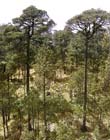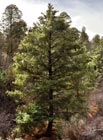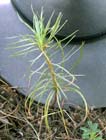
Two large trees, the taller measured at 42.1 m tall and 105 cm dbh, NW of Popocatepetl (approx. 19.1° N, 98.6° W). Understory forest dominated by P. pseudostrobus. [R. Van Pelt, 2005.02.05].

Sapling about 6 m tall, with mature trees visible behind. Same area [R. Van Pelt, 2005.02.05].

Cone about 35 cm long. Same area [R. Van Pelt, 2005.02.05].

Crown detail showing foliage, branch structure and cones in situ; same area [C.J. Earle, 2005.02.05].

Bark on 80 cm (above) and 100 cm (below) dbh trees, same area [C.J. Earle, 2005.02.05].

Seedling about 1 year old and 10 cm tall, bearing primary foliage, same area [C.J. Earle, 2005.02.05].

Pinus strobiformis subsp. veitchii
(Roezl) Frankis 2008
Common names
Pino de Navidad [Spanish].
Taxonomic notes
Syn.: Pinus veitchii Roezl 1857, Pinus popocatepetlii Roezl 1857, Pinus loudoniana Gordon 1858, Pinus ayacahuite Ehr. ex Schlecht. var. veitchii G.R. Shaw 1909, Pinus ayacahuite Ehr. ex Schlecht. subsp. loudoniana (Gordon) E. Murray 1983, Pinus ayacahuite Ehr. ex Schlecht. var. loudoniana (Gordon) Silba 1990, (Farjon 1998). Most authorities still treat it as a subspecies or variety of P. ayacahuite, but as Frankis (2008) points out, the seeds of this variety are 5 to 10 times heavier than those of P. ayacahuite and the seed-wing morphology is substantially different, distinctions that are totally anomalous with regard to infraspecific variation in any other species of Pinus; moreover, these characters are quite consistent with the type of P. strobiformis, and the subspecies occupies a comparable ecological niche as well.
Description
For particulars, see the species description. Var. veitchii is distinguished by its cones, which are 15-50 cm long with a thickened and greatly elongated apophysis, giving the whole cone a woody appearance more reminiscent of a hard pine such a P. coulteri than of typical white pines. Also, the seed winds are shorter, typically less than twice the length of the seed (Farjon and Styles 1997).
Distribution and Ecology
Mexico: Guanajuato, Hidalgo, México, Michoacán, Morelos, Puebla, Querétaro, Tlaxcala, Veracruz (Farjon and Styles 1997). See map on P. strobiformis page showing herbarium records. This tree commonly grows as an emergent in mixed conifer or pine-oak montane forests, often in areas receiving occasional snow, at (2000-)2500-3200(-3600) m elevation.
Remarkable Specimens
The largest I have seen was 137 cm dbh and 32 m tall, which we found on the NE slopes of Popocatepetl in 2005. Another tree in the same area was only 105 cm dbh, but 42.1 m tall. I have no other data on big trees.
Ethnobotany
Observations
Remarks
Citations
See also
Musalem, Miguel Angel, and Alvaro Ramírez Luis [compiladores]. 2003. Monografía de Pinus ayacahuite var. veitchii Shaw. Libro Técnico No. 6. División forestal. México, D.F.: Instituto Nacional de Investigaciones Forestales y Pecuarias. 364 p.






